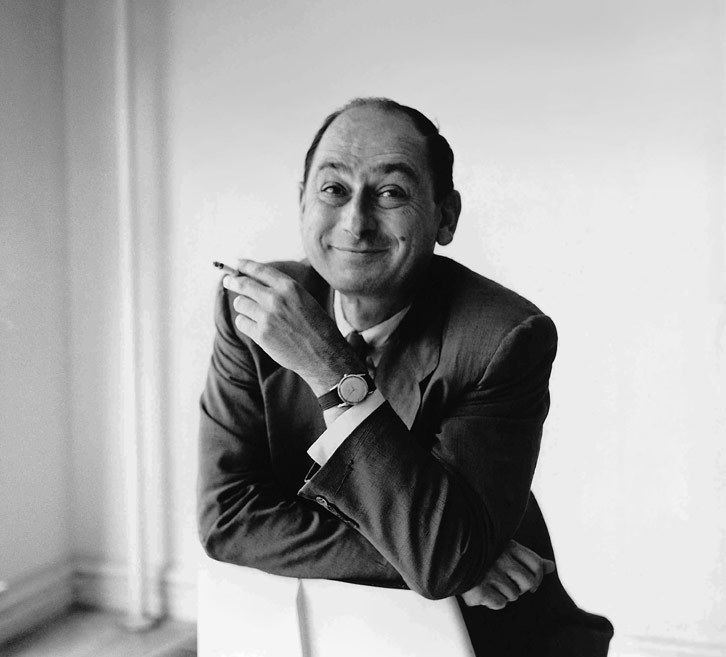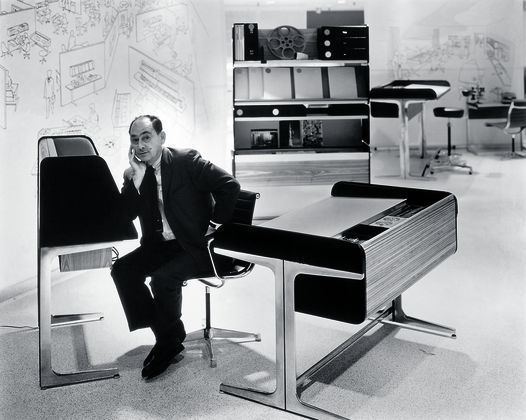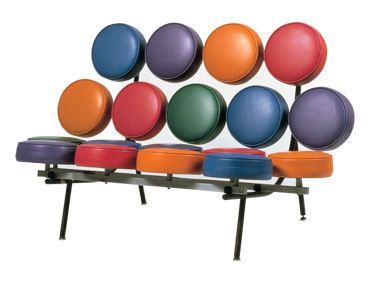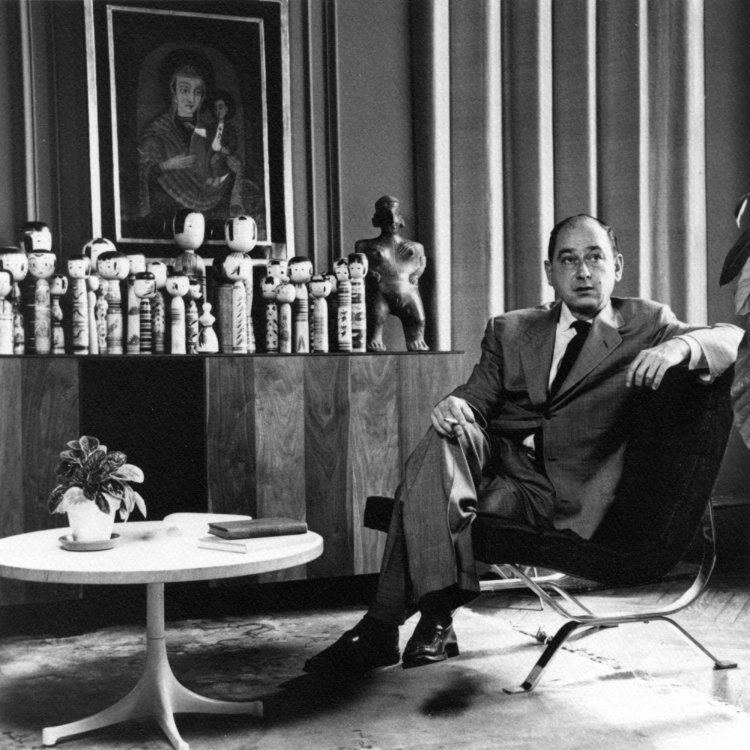Years active 1936–1986 Role Designer Organizations founded George Nelson Associates | Name George Nelson | |
 | ||
Occupation Industrial designer, architect, author, editor, teacher Died March 5, 1986, New York City, New York, United States Artwork Bubble Lamp, Platform Bench, Desk (model 4658), Vanity Seat, TERRAIN Books How to see, Problems of design, Building a New Europe: P, George Nelson on design Similar Ludwig Mies van der Rohe, Vladimir Kagan, T H Robsjohn Gibbings | ||
George Nelson (1908–1986) was an American industrial designer and one of the founders of American Modernism. While Director of Design for the Herman Miller furniture company, Nelson and his design studio, George Nelson Associates, Inc., designed much of the 20th century's most iconic modernist furniture.
Contents
- Education
- Architectural Forum
- Metadesign
- Tomorrows House
- Herman Miller
- George Nelson Associates Inc
- The office cubicle
- Influence
- Controversy
- Furniture designs
- Fairchild House
- Sling Sofa
- Quotes
- References

Education

George Nelson graduated from Hartford Public High school in 1924, thereafter attending Yale University. Nelson did not originally set out to become an architect. He happened upon the architecture school at Yale because of a rain storm, ducking into the building in order to get out of the rain. Walking through the building, he came upon an exhibit of students' works entitled "A Cemetery Gateway". Nelson met with some early recognition while still an undergraduate, being published in Pencil Points and Architecture magazine. He graduated with a degree in architecture in 1928. During his final year at Yale Nelson was hired by the architecture firm Adams and Prentice as a drafter.

In 1929, Nelson was hired as a Teacher's Assistant while getting his second bachelor's degree at Yale. He received a degree in Fine Arts in 1931. The next year, while preparing for the Paris Prize competition, he won the Rome Prize. The award for the Rome Prize was a year studying architecture with a healthy stipend and accommodations in a palace in Rome.

Based in Rome, Nelson traveled through Europe, where he met a number of the modernist pioneers, whom he interviewed for articles for Pencil Points magazine. While interviewing Ludwig Mies Van Der Rohe Van Der Rohe asked about Frank Lloyd Wright whom Nelson was embarrassed to say, he did not know much about. Years later he would work with Wright on a special issue of Architectural Forum which would come to be Wright's comeback from relative obscurity. While in Rome Nelson married Frances Hollister. A few years later he returned to the United States to devote himself to writing. Through his articles in Pencil Points he introduced the work of Walter Gropius, Mies van der Rohe, Le Corbusier and Gio Ponti to North America.
Architectural Forum

In 1935 Nelson joined Architectural Forum, where he was first associate editor (1935–1943), and later consulting editor (1944–1949). There he defended the modernist principles, arguing against colleagues who, as "industrial designers", made too many concessions to the commercial forces of the industry. Nelson believed that the work of a designer should be to better the world. In his view, nature was already perfect, but man ruined it by making things that didn't follow the rules of nature. "The contemporary architect, cut off from symbols, ornament and meaningful elaborations of structural form, all of which earlier periods processed in abundance, has desperately chased every functional requirement, every change in sight or ornamentation, every technical improvement, to provide some basis for starting his work. Where the limitations were most rigorous, as for example in a factory, or in a skyscraper where every inch had to yield its profit, there the designers were happiest and the results most satisfying. but, let a religious belief or a social ideal replace the cubic foot costs or radiation losses, and nothing happened. There is not a single modern church in the entire country that is comparable to a first-rate cafeteria, as far as solving the problem is concerned." At this point Nelson’s career still mainly involved writing for architecture magazines, and not actually designing the solutions to modern living that he would later become famous for. During this period George Nelson spent a great deal of time interviewing and exchanging ideas with the other founders of the modernist architecture movement of the forties, including Eliot Noyes, Charles Eames, and Walter B. Ford, all of whom he would later collaborate with.
Metadesign
It has been argued that Nelson might be called a metadesigner - that his intent of study and practice was neither the building nor the product but rather the process of design itself. Nelson's manner of interdisciplinary design and therefore progressive thinking reoriented the entire concern with capitalist destruction around the dynamic of producer and product.
However, when comparing the careers of other designers, he seemed not only unconventional and tastefully noncommercial, but at times negative. "...it is the career of an architect who advocated the end of architecture, a furniture designer who imagined rooms without furniture, an urban designer who contemplated the hidden city, an industrial designer who questioned the future of the object and hated the obsession with products."
Tomorrow's House
By 1940 George Nelson had become known for several innovative concepts. In his post-war book Tomorrow's House, co-authored with Henry Wright, he introduced the concept of the "family room", and the "storage wall". The storage wall was essentially the idea of recessed, built-in bookcases or shelving occupying space previously lost between walls. It was an idea developed while writing the book, when Nelson's publisher was pressuring him to finish the section on storage. Neither Wright nor Nelson could find any new innovations when Nelson posed the question, "What's inside the wall?", It was then that the idea of utilizing the space in between walls for storage was born. Tomorrow's House was innovative because it didn’t look at modern design as a case of styles, but instead looked at the way problems needed to be solved.
Herman Miller
In 1945, the Herman Miller furniture company was producing mostly conventional, wood-based designs. After reading Tomorrow's House D.J. Depree, the Chairman of Herman Miller, selected Nelson to be the company's next Director of Design, despite Nelson having no experience designing furniture. Depree was more interested in Nelson’s insight into the best way to make furniture innovative and useful. Nelson was offered a contract that allowed him the freedom to work outside of Herman Miller, and to use designs from other architects that Nelson had worked with. He became the Director of Design for Herman Miller in 1947, and held the position until 1972. The first Herman Miller catalog produced by Nelson was released in 1945. Over the following years it would include some of the most iconic home furnishings of the 20th century. Ray and Charles Eames, Harry Bertoia, Richard Schultz, Donald Knorr, and Isamu Noguchi all worked for Herman Miller, under Nelson's supervision. Although both Bertoia and Noguchi later expressed regrets about their involvement, it became a successful period for the company, and for George Nelson.
George Nelson Associates, Inc.
Using the money he earned as Director of Design for Herman Miller, in 1947 Nelson opened a design studio in New York City. On October 26, 1955 he incorporated it into George Nelson Associates, Inc., and moved to 251 Park Avenue South. The studio was successful in bringing together many of the top designers of the era, who were soon designing for Herman Miller under the George Nelson label. Among the noted designers who worked for George Nelson Associates, Inc. were Irving Harper, George Mulhauser (designer of the Coconut Chair), Robert Brownjohn (designer of the sets for the James Bond film Goldfinger), Don Chadwick, Bill Renwick, Suzanne Sekey, John Svezia, Ernest Farmer, Tobias O'Mara, George Tscherney, (who designed the Herman Miller advertisements), Lance Wyman, and John Pile. With his studio, Nelson enacted new practices for the involvement of design in all aspects of the company, pioneering the practice of corporate image management, graphic programs, and signage. By the time the company closed in the mid-1980s George Nelson Associates, Inc. had worked with most of the Fortune 500 companies. George Nelson's architectural projects included what he dubbed "The Colombian Garden of Health", a 200 bed tertiary care hospital in Bogota, Colombia, commisoned by the Fundacion Santa Fe de Bogota.
The office cubicle
In 1960 Herman Miller created the Herman Miller Research Corporation under the direction of Robert Propst, and the supervision of George Nelson. Although Nelson remained at Herman Miller's main campus in Zeeland, Michigan, Robert Propst and the Herman Miller Research Corporation was located in Ann Arbor, Michigan to place it in close proximity to the University of Michigan campus. The company's purpose was to examine changes in the use of office furniture that had taken place during the 20th century, but not the furniture itself. After consulting with experts in psychology, anthropology, and various other fields, Propst created the Action Office I line, which was executed by Nelson's studio, and first appeared in Herman Miller's 1964 catalog. For designing the Action Office I Nelson was awarded the prestigious Alcoa award. The Action Office I line was not a success, and Nelson was removed from the project. Propst then created the Action Office II, which is better known today as the "Office cubicle". Despite the "Action Office II" line becoming Herman Miller's most successful project, George Nelson disowned himself from any connection with the project. In 1970 he sent a letter to Robert Blaich, who had become Herman Miller's Vice-President for Corporate Design and Communication, in which he described the system's "dehumanizing effect as a working environment." He summed up his feeling by saying:
"One does not have to be an especially perceptive critic to realize that AO II is definitely not a system which produces an environment gratifying for people in general. But it is admirable for planners looking for ways of cramming in a maximum number of bodies, for "employees" (as against individuals), for "personnel," corporate zombies, the walking dead, the silent majority. A large market."
Scornful as he may have been, Nelson was right that there turned out to be a "larger market" for AO II. By 2005 total sales had reached $5 billion.
Influence
The George Nelson Associates, Inc. catalog, and exhibition designs for Herman Miller, made modernism the most important driving force in the company. From his start in the mid-forties until the mid-eighties George Nelson Associates, Inc. partnered with most of the modernist designers of the time. This was both the result of Nelson’s time as a magazine editor, and because of Nelson's writing. His skill as a writer helped legitimize and stimulate the field of industrial design by contributing to the creation of Industrial Design magazine in 1953. Nelson wrote extensively, published several books, and organized conferences like the Aspen design gatherings, where for more than 30 years he was the guiding force. In 1971, he received a grant from the Graham Foundation for his project "Hidden Cities". One of George Nelson's areas of interest was the reduction of pollution. Through his attempts to reduce all forms of pollution, including visual, audio, and chemical, Nelson pioneered the idea of the outdoor shopping mall, first using the idea in a proposal for the city plan of Austin, Texas, which was not used.
George Nelson retired with the closing of his studio in the mid-1980s. He died in New York City in 1986.
Controversy
In recent years it has become known that many of the designs George Nelson accepted credit for were actually the work of other designers employed at his studios. Examples of this include the Marshmallow sofa, which was actually designed by Irving Harper, and the Action Office, for which Nelson won the prestigious Alcoa Award, neglecting to mention that it was largely designed by Robert Propst. John Pile, a designer who worked for Nelson in the 1950s, commented about this practice; "George's attitude was that it was okay for individual designers to be given credit in trade publications, but for the consumer world, the credit should always be to the firm, not the individual. He didn't always follow through on that policy though."
In an interview in Metropolis in 2001, Irving Harper also commented on this practice: "...there always had to be one name associated with the work. We couldn't just spread it around… that's fine. I'm grateful to George for what he did for me. While he was alive, I made no demands whatsoever, but now that he's gone, whenever the Marshmallow Sofa is referred to as a 'George Nelson design', it sort of gets to me. I don't go out of my way to set things right, but if anybody asks me who designed it, I'm perfectly happy to tell them."
Furniture designs
(# currently available from Herman Miller)
His firm, George Nelson Associates, also designed a large series of wall and table clocks for the Howard Miller company, as well as a range of hanging Bubble Lamps, which had plastic membrane-covered wire-form shades (also for Howard Miller, but currently available from Modernica (http://www.modernica.net), wrought iron fireplace pieces, planters, room dividers, ceiling-mounted "Ribbon Wall," spice cabinets, and many other products that became milestones in the history of a profession that he helped to shape.
A number of the nearly 300 classic wall clocks for Howard Miller Clock Company (including the Ball, Kite, Eye, Turbine, Spindle, Petal and Spike clocks, as well as a handful of desk clocks) are currently available from Vitra. Most were designed by Irving Harper. Subsequently, Vitra has discontinued some of the clocks based on sales.
All the original clock designs were simply assigned numbers by Howard Miller. Probably the most recognisable of the series, the Ball Clock, was advertised and sold as ‘Clock 4755’; the Sunflower Clock as ‘Clock 2261’. Several colour variations were available for many of the clocks. The Ball Clock was available in six colour variations, the Sunflower Clock in three. One of the more unusual designs, the Eye Clock (‘Clock 2238’) was pictured in the original Howard Miller Clock Company brochures in a diagonal position, not horizontal, as would be expected.
Fairchild House
New York, New York. USA 1941-The Fairchild House was built for the Airplane manufacturer Sherman Fairchild and was meant to be a "machine for living. What made the Fairchild House different from every other Brown Stone in New York was its views. There was a courtyard in the middle of the building and all the windows faced in toward it. This made the home feel more tranquil and the view provided use for Nelson's signature floor to ceiling windows. Much of the house is designed in style not necessarily common in early modern design. This is evidence of Nelson's philosophy that "good design is timeless."
Sling Sofa
Herman Miller 1963- This sofa is made of leather and filled with solid foam cushions. The joints are all held with epoxy so that it can be more easily mass-produced and sold for a cheaper price. There is no need for hand crafting with this sofa. Because of its perfect proportions and light appearance it doesn't look like it's just an elongated chair. Nelson's use of a single welt along the perimeter of the padding gives the seating an approachable softness and yet, there is more going on that cannot be seen. The padding is held up by rubber bands that allow for more comfort and the use of epoxy for the joints gives the shape a much smoother feel. It is a modern design only because it was made recently. Like most of Nelson's work it was only designed to be as useful and comfortable as possible.
